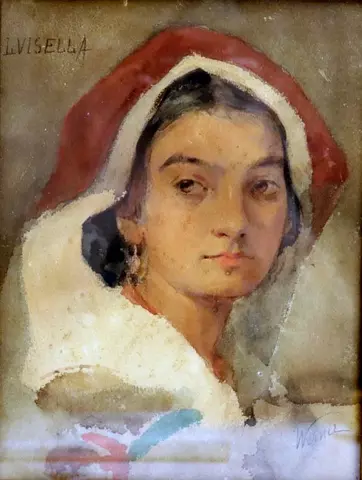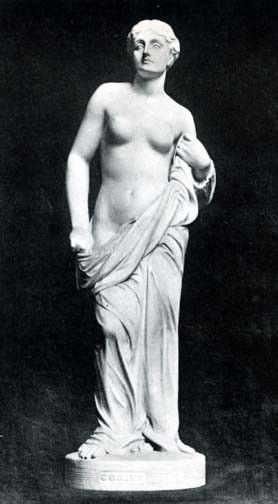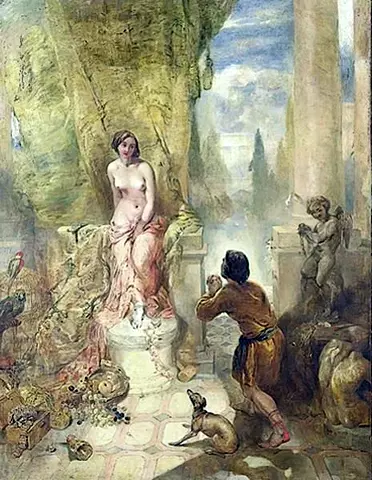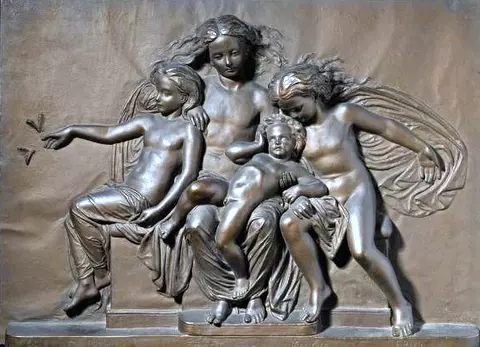WOOLNER, Thomas
Thomas Woolner was born at Hadleigh, Suffolk on 17 December 1825, son of Thomas Woolner (1805-24 December 1868) and his first wife, Rebecca née Leeks and after her death, Thomas, sen. and his three children, including Henry Woolner, moved to Witnesham, Suffolk to live with his Leek in-laws. Thomas, senior's second wife Sarah née Stone (1807-1891), died at Otley, Suffolk on 20 September 1891, aged 84. After schooling at Ashbocking, Suffolk, about 1830 his father joined the Post Office and they moved to London where young Thomas studied under a Mr Lyne. At the age of twelve, indentured to artist Charles Behnes (died 1840), and on Charles Behnes death, Thomas joined Behnes's brother William (c1795-1863), a talented portrait sculptor, who trained him, particularly in carving, and when his apprenticeship finished, Behnes found work for him. On 16 December 1842, Thomas entered the Royal Academy Schools and first exhibited at the Royal Academy the following year, but his life-size plaster group ‘Death of Boadicea’ was unsuccessful in the 1844 Westminster Hall competition for commissions for the new Palace of Westminster. His earliest important surviving work is the statuette of Puck (plaster, 1845–7) which was admired by William Holman Hunt (1827-1910). An event that set the course of Woolner's career occurred in 1847 when he met his new studio neighbour, Dante Gabriel Rossetti (1828-1882) when the two of them, along with John Everett Millais (1829-1896) and William Holman Hunt (1827-1910), joined the Cyclographic Society, a sketching club. This foursome, together with three other young artists, formed the Pre-Raphaelite brotherhood in 1848, a major force in British art in the 1850s and early 1860s. Woolner's poem ‘Our Beautiful Lady’ is the opening piece in the first issue of their short-lived journal 'The Germ', published in 1850. In 1851, Woolner was living at Mary (now Stanhope) Street with his father and stepmother Sarah and eight children. His defeat by Frederick Thrupp (1812-1893) in the competition for the national monument to Wordsworth for Westminster Abbey, together with his modest critical and financial success, persuaded Woolner in 1852 to try gold prospecting in Australia together with Bernard Smith (1820–1885), a sculptor, and Edward Latrobe Bateman (1816-1897), nephew of the governor of Victoria. Reckoning that his £50 of gold had cost him £80, Woolner abandoned prospecting in 1853 and returned to Melbourne to sculpt. He modelled numerous portrait medallions at £25 each, including one of William Charles Wentworth (1790-1872), the campaigner for self-government for New South Wales. Although busy, the lack of an established record of public sculpture prevented him from obtaining the major commissions necessary to fulfil his ambitions, so he returned to England in 1854. Woolner persuaded Alfred Tennyson (1809-1892) to sit for a new portrait medallion and a marble bust, finished in 1857, which proved to be the turning point of Woolner's career, establishing him as an outstanding bust-maker of men but he rarely tackled women. Oxford University gave Woolner his first public commission, a limestone figure of Francis Bacon (1761-1828), which cost £70 in 1857, for a series of great scientists for the Gothic revival University Museum. In the same year Hunt introduced Woolner to his patron, Thomas Fairbairn (1823-1891) of Manchester, who ordered a poignant group of his deaf and dumb children, Constance and Arthur. With growing critical and financial success, in 1861 Woolner purchased for £1,200, 29 Welbeck Street, London, which he initially shared with the critic Francis Turner Palgrave (1824-1897) of Great Yarmouth, and where he lived until his death. On 6 September 1864 he married Alice Gertrude Waugh, with whom he had six children including Dorothy and Phyllis who both had pictures accepted by the Royal Academy. His patrons tended to come from learned institutions or to be serious-minded, with artistic pretensions and social consciences but he himself taught at the London Working Men's College. His published work includes 'My Beautiful Lady' (1863), 'Pygmalion' (1881), and 'Silenus' (1884). Elected an associate of the Royal Academy on 26 January 1871 and a Royal Academician on 29 January 1874 and appointed professor of Sculpture at the academy in 1877, but he resigned five years later. Thomas Woolner died at his home in Welbeck Street on 7 October 1892 and was buried at St Mary's, Hendon. His wife Alice died at Welbeck Street on 9 March 1912, aged 67.
Royal Academy Exhibits
from 15 Mary Street, Regent's Park
1843 1442 Model of Eleanor sucking the venom out of the wound &c. - sculpture
1847 1394 Feeding the Hungry - sculpture
1848 1339 Eros and Euphrosyne - sculpture
1411 Medallion of a Gentleman - sculpture
1414 The Rainbow - sculpture
from 101 Stanhope Street, Mornington Crescent
1852 1344 Design for a Medal Competition of the Lever - sculpture
1346 Design for a Medal England Rewards Agriculture - sculpture
1353 Sketch for a Monument to William Wordsworth - sculpture
1396 Medallion of Thomas Carlyle, Esq. - sculpture
1397 Medallion of William Wordsworth - sculpture
1398 Medallion of a Lady - sculpture
from 27 Rutland Street, Hampstead Road
1856 1282 W C Wentworth, Esq., late of Sydney, New South Wales - sculpture
1283 Charles Ernest Howitt - sculpture
1285 G W Cole, Esq., late of Melbourne, Victoria - sculpture
1342 Thomas Carlyle, Esq. - sculpture
1857 1367 Robert Browning, Esq. - medallion
1368 Thomas Carlyle, Esq. - medallion
1369 Medallion of a Lady
1370 Alfred Tennyson, Esq. - medallion
1858 1203 Moses on Mount Sinai - sketch
1204 St John the Baptist - sketch
1321 Thomas Fairbairn, Esq. - medallion
1859 1244 Thomas Fairbairn, Esq. - sculpture
1317 Sir James Brooke, K.C.B., Rajah of Sarawak - sculpture
1379 George Warde Norman, Esq. - medallion
1380 Mrs Alfred Tennyson - medallion
1860 991 George Wade Norman, Esq. - medallion
992 Edward H T Norman, Esq. - medallion
993 Alexander A Knox, Esq. - medallion
1075 Sir William Hooker- sculpture
1861 986 Rev William George Clarke, M.A.- sculpture
996 Sir Francis Palgrave- sculpture
1080 William Shaen, Esq.- sculpture
1862 1048 William Fairbairn, Esq.- sculpture
1863 1141 The late Archdeacon Hare - sculpture
1864 1024 Mr Combe of the 'Clarendon Press' - sculpture
1049 Rev W Gifford Palgrave - medallion
1866 932 Puck - sculpture
1867 1091 Alfred Tennyson, Esq. - medallion
from 29 Welbeck Street, London
1868 948 Elaine with the Shield of Sir Launcelot - sculpture
1001 Hon. William Edward Frere, late of Bombay - sculpture
1007 Thomas Carlyle, Esq. - sculpture
1027 Reliefs from the 'Iliad' - sculpture
1029 The late Robert Leslie Ellis - sculpture
1869 1151 E. Wilson, late of Melbourne in Australia - sculpture
1241 J. Pease of Darlington - sculpture
1248 Ophelia - sculpture
1268 Right Hon. W.E. Gladstone - sculpture
1285 Sir Bartle Frere, late Governor of Bombay - sculpture
1870 1115 Sir James Hope Grant - sculpture
1198 Charles Darwin, Esq. - sculpture
1222 In Memoriam - sculpture
1871 1277 Virginia - sculpture
1282 Dr. Temple, Bishop of Exeter - sculpture
1295 Mrs Hitchins - medallion
1303 Sir Hope Grant - sculpture
1872 1468 Instructing the Innocent - sculpture
1469 In Memoriam, G.B. - sculpture
1503 Guinevere - sculpture
1513 Sir Bartle Frere, K.C.B. - sculpture
1546 The late Mrs. Milnes Gaskell - sculpture
1560 The late Charles Dickens - sculpture
1570 Mrs. William Cleverley Alexander - medallion
1576 Mercury teaching a shepherd boy to sing - sculpture
1873
1874
1876
1877
1878
1879
1880
1882
1883
1884
1885
1888
1889
1890
1891
1893
Works by This Artist

|
Girl in a BonnetWatercolour
|

|
GodivaMarble |

|
The FarewellOil on canvas
|

|
Triumph of LoveOil on canvas |

|
In MemoriamGalvanised plaster sculpture
|